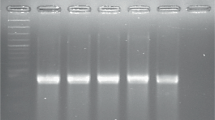Abstract
Soft rot, a major bacterial disease affecting the production of Chinese cabbage (Brassica rapa L. ssp. pekinensis) in China, has been widely attributed to Pectobacterium carotovorum subsp. carotovorum. Outbreaks of a new disease of Chinese cabbage caused considerable economic losses in many varieties from June to July of 2018 and 2019 in Harbin, China. This new disease had symptoms similar to those of soft rot but was different from bacterial rot caused by Pcc. Plants affected by this disease showed rot at the midrib of their leaves and stumps with short hyphae. A fungal strain named DBC755 was isolated from plant samples exhibiting soft rot to determine the relevant pathogen. The pathogen had a radial colonial morphology, white hyphae, and luxuriant branches in potato dextrose agar culture medium. The isolate was identified as Pythium ultimum var. ultimum on the basis of its morphology, biological characteristics, internal transcribed spacer, β-tubulin gene and coxII gene sequence analyses. A pure fungal culture was inoculated on Chinese cabbage, and rot symptoms were consistent with those observed in the field to satisfy Koch’s postulates. The discovery and biological characteristics of P. ultimum var. ultimum causing rot in Chinese cabbage provides a deeper understanding of soft rot and has great importance for the breeding of Chinese cabbage with resistance to this disease.




Similar content being viewed by others
References
Abdelzaher HMA (2003) Biological control of root rot of cauliflower (caused by Pythium ultimum var. ultimum) using selected antagonistic rhizospheric strains of Bacillus subtilis. N Z J Crop Hortic Sci 31:209–220
Abdelzaher HMA, Elnaghy MA, Fadl-Allah EM (1997) Isolation of Pythium oligandrum from Egyptian soil and its mycoparasitic effect on Pythium ultimum var. ultimum the damping-off organism of wheat. Mycopathologia 139:97–106
Ausubel FMt, Brent R, Kingston RE, Moore DD, Seidman JG, Smith JA, Steriaruhl K (1987) Current protocols in molecular biology. Greene Publishing Associates Wiley Interscience, New York
Babai-Ahary A, Abrinnia M, Heravan IM (2004) Identification and pathogenicity of Pythium species causing damping-off in sugarbeet in northwest Iran. Australas Plant Pathol 33:343–347
Baker KF, Cummings K (1943) Control of Pythium root rot of Aloe variegata by hot -water treatment. Phytopathology 33:736–738
Felsenstein J (1985) Confidence limits on phylogenies: An approach using the bootstrap. Evolution 39:783–791
Guo M, Liu Y, Liu SN, Qu QZ, Cui TF, Zhang YW (2019) First Report of Bacterial Soft Rot Caused by Pantoea agglomerans on Chinese Cabbage in China. Plant Dis. https://doi.org/10.1094/PDIS-04-19-0746-PDN
Guohui M, Fengying W, Yaowei Z (2012) Identification and comparison of the biological characteristics of the pathogen causing brown rot of Chinese cabbage in Tianjin and Heilongjiang. Plant Prot 38:89–95
Kida K, Tojo M, Yano K, Kotani S (2007) First report of Pythium ultimum var. ultimum causing damping off on okra in Japan. Plant Pathol 56:1042
Kikumoto T (1987) Pythium rot of Chinese cabbage (new disease). Ann Phytopathol Soc Jpn 53:376 (abstract in Japanese)
Kubota M, Nakasuji S, Shimizu M, Nishi K (2006) Damping-off of cabbage plug seedlings caused by Pythium ultimum var. ultimum in Japan. J Gen Plant Pathol 72:123–125
Matoba Y, Kondo N, Akino S, Kodama F, Naito S, Ebe S (2008) Identification and pathogenicity of Pythium species causing damping-off of kidney bean. J Gen Plant Pathol 74:81–85
Meidute S, Demoling F, Bååth E (2008) Antagonistic and synergistic effects of fungal and bacterial growth in soil after adding different carbon and nitrogen sources. Soil Biol Biochem 40:2334–2343
Mo MH, Xu CK, Zhang KQ (2005) Effects of carbon and nitrogen sources, carbon-to-nitrogen ratio, and initial pH on the growth of nematophagous fungus Pochonia chlamydosporia in liquid culture. Mycopathologia 159:381–387
Møller K, Hockenhull J (1997) Leaf and head rot of Chinese cabbage - a new field disease caused by Pythium tracheiphilum Matta. Eur J Plant Pathol 103:245–249
Mubeen Lodhi A, Qayoom A, Shahzad S, Ghaffar A (2005) Pythium ultimum var. ultimum, a new record from Pakistan. Pak J Bot 37:779–782
Onkendi EM, Moleleki LN (2014) Characterization of Pectobacterium carotovorum subsp. carotovorum and brasiliense from diseased potatoes in Kenya. Eur J Plant Pathol 139:557–566
Sudhir K, Glen S, Koichiro T (2016) MEGA7: Molecular Evolutionary Genetics Analysis Version 7.0 for Bigger Datasets. Mol Biol Evol 33
Sun J-x, Zhang L-g (2015) Identification and Main Biological Characteristics of Sclerotinia Rot Pathogen in Chinese Cabbage. Acta Agric Boreali-Simica 30:321–328
Tamura K, Nei M, Kumar S (2004) Prospects for inferring very large phylogenies by using the neighbor-joining method. Proc Natl Acad Sci (USA) 101:11030–11035
Tanina K, Tojo M, Date H, Kasuyama HNS (2004) Pythium rot of chingensai (Brassica campestris L. chinensis group) caused by Pythium ultimum var. ultimum and Pythium aphanidermatum. J Gen Plant Pathol 70:188–191
Tojo M, Shigematsu T, Morita H, Li Y, Matsumoto T, Ohki ST (2005) Pythium rot of Chinese cabbage (Brassica rapa L. subsp. pekinensis) caused by Pythium aphanidermatum. J Gen Plant Pathol 71:384–386
Van Der Plaatsniterink AJ (1981) Monograph of the genus Pythium. Stud Mycol 21:1–242
Villa NO, Kageyama K, Asano T, Suga H (2006) Phylogenetic relationships of Pythium and Phytophthora species based on ITS rDNA, cytochrome oxidase II and β-tubulin gene sequences. Mycologia 98:410–422
Waterhouse GM (1967) Key to Pythium Pringsheim. Mycol Pap 109:1–15
White TJ, Bruns T, Lee S, Taylor J (1990) Amplification and direct sequencing of fungal ribosomal RNA genes for phylogenetics. In: Innis MA et al (eds) PCR Protocols. Massachusetts, Cambridge, pp 315–322
Acknowledgments
This work was supported by the Foundation for the National Key Research and Development Program of China (2017YFD0101801-6), by Ministry of Science and Technology of the People ‘s Republic of China, and Technology Innovation System of Vegetable Industry in Heilongjiang Province (HNWSCTX2019), by Rural and Agricultural Department of Heilongjiang Province in the People ‘s Republic of China.
Author information
Authors and Affiliations
Corresponding author
Rights and permissions
About this article
Cite this article
Li, J., Zhang, Y. Biological characteristics and isolation of Pythium ultimum causing rot of Chinese cabbage. Australasian Plant Pathol. 49, 201–207 (2020). https://doi.org/10.1007/s13313-020-00692-x
Received:
Accepted:
Published:
Issue Date:
DOI: https://doi.org/10.1007/s13313-020-00692-x




